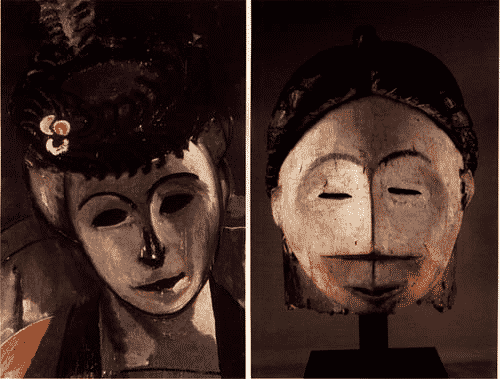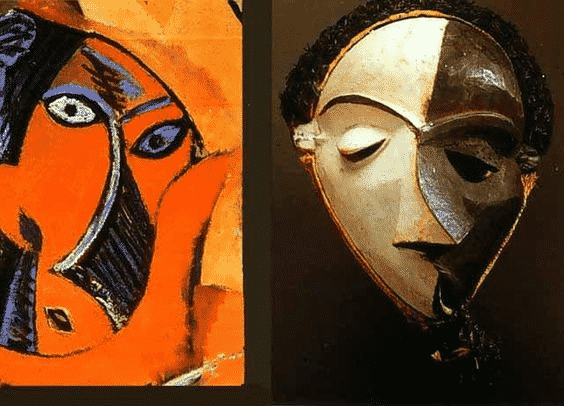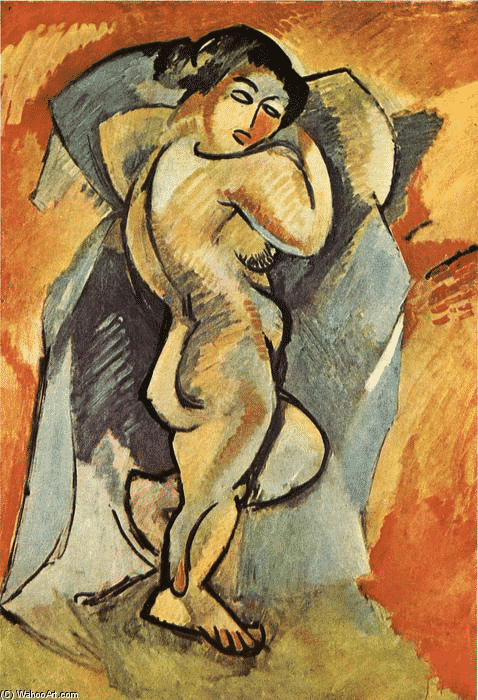Name the Three Modernist Art Styles That Were Influenced or Based on African Tribal Art
In the early 1900s, the Parisian press had the public buzzing with exotic tales about the African kingdom. Exaggerated stories of savagery and cannibalism sparked a fascination for the land that the French were increasingly occupying. But with French colonies expanding throughout Sub-Saharan Africa, the French learned more nearly the civilization, discovering its beauty and art. Many African artifacts that were not quite yet referred to as artwork went to Paris museums such equally the Musée d'Ethnographie du Trocadéro. They also establish their way to museums in London, Berlin, and Munich. And while museums began to fill up with many priceless African artifacts, information technology would be a small African figurine carved out of woods that became instrumental to African art'south touch on on modern art. The Vili people of the Congo created the sculpted figure and caught the attending of legendary artists, such every bit Henri Matisse and Pablo Picasso. They immediately appreciated that while the piece was primitive, it was sophisticated in its abstraction, lending itself equally a point of inspiration.

African Art and Henri Matisse
French creative person Henri Matisse traveled extensively, allowing many different cultures to influence his work. In 1906, he went to Algeria and after studying African art, became enamored by information technology. African fine art began to shape much of his work as he skillful many of the same styles and techniques seen in African masks and fabrics. It was also that same year that Matisse met Spanish artist Picasso who would become his lifelong friend and rival.
To date, some of Matisse'due south most notable works have evidence of African art artful influence. His slice from 1907, Marguerite, is a depiction of his daughter rendered in similar class to the African mask he owned. Likewise, as seen in the image above, Matisse'southward depiction of this wife has clear structural and tonal qualities that resemble the aesthetic techniques used in African masks. Particularly, the arc of the eyebrows and the upward curve of the mouth on Madam Matisse, seem to mirror those elements in the Mask of Sira Punu. Another notable example portraying African influence is Matisse'southward Red Interior still life on a blue table, 1942. The assuming geometric pattern seen in the piece is similar to the Kuba cloth, an African handwoven cloth by the Kuba people of Congo.

Pablo Picasso's African Period
Picasso's African Catamenia also referred to his Proto-Cubist or primitivism period, would final from 1907 to 1909. It was at the ethnographic museum at Palais du Trocadéro that the then 24-year-old Picasso truly experienced a "revelation" as he explored African art further. Picasso became strongly influenced past traditional African masks and sculptures in particular.
Picasso'south seminal painting Les Demoiselles d'Avignon 1907 — a portrayal of five nude prostitutes, was the virtually notable withdrawal from his typical way of Blue and Rose Period, leading to his African Period. It had the aesthetics of traditional African art with figures that had African mask-similar features. The piece would ultimately spark the Cubist movement.
Inspired heavily by traditional African masks, Picasso used a palette of bawdy tones, overlapping browns, and yellows with dark reds. Other works from Picasso'southward African Menstruum include Portrait of Gertrude Stein 1906, Nude with Raised Arms 1907, Dryad 1908, and Iii Women 1908.

African Art's Impact on the Cubist and Mod Art Movement
Led past Picasso and Parisian painter Georges Braque, the Cubist art movement began in 1907. Cubism explored geometry and the redefinition of perspectives. It attempted to reveal objects from a dissimilar vantage bespeak – from the listen and not only how the eyes perceive them. Cubists who aimed at resisting conventional mode and subject field-thing welcomed the influences of their travels, especially the "primitive" art that came back from Africa.
Georges Braque describes "African masks" every bit the opening "a new horizon for me. They made it possible for me to make contact with instinctive things, with an uninhibited feeling that went against the fake tradition which I hated." Some of Braque'due south work that was visibly influenced by Picasso, Cubism, and African art include Large Nude 1908 (epitome in a higher place).
From ceremonial masks to costumes to religious statues, African artifacts and sculptures contributed a powerful influence to the development of the modernistic art motility during the early 20th century. From exotic abstractions to vivid expressions, they ignited a significant artistic departure from what the Western audience was accustomed and comfortable with. Their clashing colors, fragmented geometric patterns, and powerful primitive imaginations attracted many to their forms. Cubists and other European avant-garde artists who were hungry for viscerally new and dynamic languages of innovation were particularly drawn to the unique elements of representation in African fine art, launching forward a whole new fine art movement.
Source: https://www.artdex.com/historical-influence-of-african-art-in-the-modern-art-movement/
0 Response to "Name the Three Modernist Art Styles That Were Influenced or Based on African Tribal Art"
Post a Comment